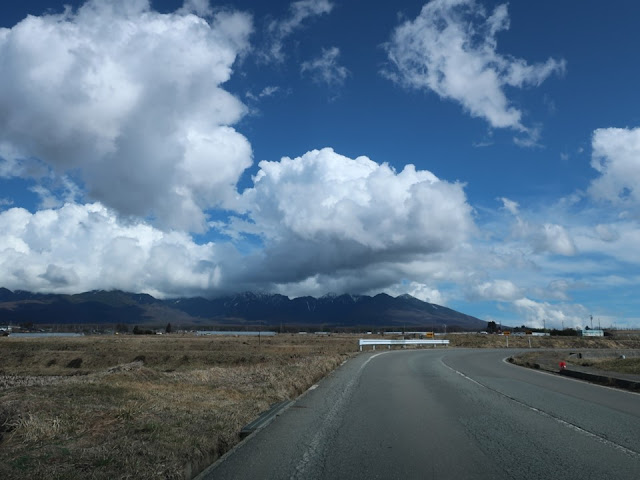The museum is in central Japan (Nagano pref.). It is at the foot of Yatsugatake Mountains (elevation of the highest point is 2,899 m). We can know the local life well.
Although it is a cold area, people
take advantage of the coldness; they have manufactured kanen (agar
products) which is a specialty now. I wonder what supports their spirit; is it
faith in Suwa deity? Anyway, they have led life; they are strong. The museum
does a lot work on education such as citizen researcher.
The renowned and attractive festival in the area is Onbashira festival. People cut great trees every six years, draw them to the Suwa shrine and raise them up around the main hall. The exhibit above was attached at the front of the wood.
玄関脇には御柱を曳くときに先頭に付けられるメドデコが展示されています。諏訪大社をお祀りする地域らしいですね。
Nature of Chino City、茅野市の自然
Once entering the first exhibition room, Mt. Yatsugatake (model on the left) erupts.
展示室に入ると音をあげて噴火する八ヶ岳の模型が迎えてくれます。
Creatures are displayed in the next room. Creatures at low mountain area are exhibited in front, the ones at high mountains are did in behind.
次の部屋は生き物の展示。手前から低山帯、亜高山帯、高山帯の生物が展示されています。
人里に近い低山帯には植物を食べる野ねずみや、それを食べるイタチ、植物も動物も食べるタヌキやイノシシが住んでいます。そして、それらを食べる人間がいるわけで、このパネルを見ると、生かされているということを意識しないといけないと改めて思います。
Life in the foot of Yatsugatake Mountains、八ヶ岳山麓の暮らし
There are exhibits about Onbashira festival in center, about history in front and about folklore in behind.
中央に御柱祭で使われた綱などが展示されています。手前に歴史、奥に民俗についての展示品が並びます。
The land is frozen from December to March, it means they cannot farm. They not only made straw products inside house but also did iron products such as saw or farming tools. Manufacturing saw became their business through four seasons.
茅野では、12月頃から3月末まで大地が凍って農作業ができません。藁細工だけでなく、展示されている鋸や農具の製造にも取り組みました。鋸は「信州鋸」として専業化し、立派な地場産業になりました。
The area is cold and sunny in winter. People have made traditional frozen-dried foods.
They boiled agar in the cauldron in behind, then dried them on the shelves in front. Water contained in agar is frozen in the night, and is dried (vaporized) in the daytime. It is a well-known preserved food; the efficacy in improving metabolism is founded recently and becomes popular. I like traditional freeze-drying foods for example daikon (Japanese white radish), because it absorbs soup well.
Locals went to work to the bayside of Tokyo in winter. I just guess they built connection with people at bayside and could obtain seaweed (material of agar). Although they live in a cold area, they devised to lead their life.
寒くて晴天が多い冬の気候を利用して、寒天や凍り餅などの凍み食品づくりが行われてきました。奥の大釜(直胴部が木製)で煮た海藻を、手前右の棚で干しました。味がよくしみ込んで美味しい伝統的な保存食ですが、代謝改善の健康効果が認められ人気の食品になっています。
茅野では、冬季に大森(東京)の海苔屋へ出稼ぎに行っていた人がいたので、海藻を手に入れられたのかもしれません。寒いなら寒いなりに工夫して生きていく人々の力強さを感じます。
A full-scale private house is exhibited. The wooden plates (enlarged photo on the right) were used to serve pickled vegetables to visitor like sweets. It is a local, interesting and joyful custom; the tastes and textures of handmade pickled vegetables vary.
実物大の民家が展示されています。食器類の展示棚の中に桧の皿の「おへぎ」(右の拡大写真)があり、「来客用の菓子、漬物の受け皿に用いました」と書かれています。おやつに漬物を食べるのが信州のお茶請け文化。お茶菓子と漬物は同じ扱いになります。漬物はそれぞれの家庭の味を楽しめるので、とても良い文化だと思います。
There is a stable in the house. A skull of a monkey is hung (enlarged photo). It was common custom across Japan, because monkey was believed as guardian angel of horse. People hang it and prayed for good health of horse.
中に入ると右側に馬小屋の模型があります。厩猿(猿の頭骨、左上)がかけられています。馬の無病息災を願う全国的な習慣です。猿は馬の守り神です。
We can go up to the floor of the living room and can hear an old tale. Family members gathered around the irori (fireplace). The seed container would be a dried gourd; there are no plastic products in the house.
囲炉裏の間に上がれ、昔話(録音)も聞けるようになっています。家族は囲炉裏端で暮らしました。種を入れる容器は、瓜でしょうか。この部屋にプラスチックはありません。
The irrigation in the Edo period (1603~1868) is exhibited in the room above. Sakamoto Yousen (1736-1809), who was a village head, went to Tokyo to learn irrigation. Then, he led to build agricultural waterways; some of them go over a river (upper right). Production volume got 50% increase.
Btw, the water is warmed before is poured to rice field. Civil engineering is necessary for farming.
坂本養川(1736-1809)は庄屋でしたが、江戸で用水路作りを学び、諏訪盆地に水路を巡らせました。右上のように川を越える樋もあります。その結果、水田が増え、この地域の石高は1.5倍になりました。見習うべき先人として一部屋をつかって業績や人となりが説明されています。
ところで、諏訪地域では、折り返す水路で水を温めてから水田に入れる「ぬるめ」なども作り水田開発を行ったことが、稲作のコーナーで紹介されていました。土木技術は農業に必須ですね。
View of Yatsugatake Mountains from the nearby museum. The mountain foot has been developed as agricultural field.
博物館の近くから見た八ヶ岳連峰。麓には農地が広がっています。
Chino city is on Koshu-kaidou (highway) which led to Tokyo.
茅野市は新宿と中山道を結ぶ甲州街道上にあります。
Official website: https://www.city.chino.lg.jp/site/y-hakubutsukan/
(in Japanese), accessed in December, 2024
Visited in March, 2024
Previous post (museum in the same area): Lake
Suwa museum、諏訪湖博物館
Next post (museum in the neighboring town): Fujimi Historical Folklore Museum、富士見町歴史民俗資料館














Comments
Post a Comment